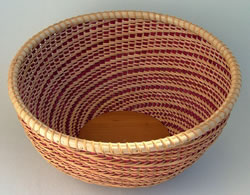|
A true “Renaissance” woman,
in the modern sense of the phrase, Deborah Shank has talents
and interests that intersect math, architecture, theater,
photography, and archeology. With so many gifts, she struggles
to find time for one of her greatest passions, basketry.
Shank creates baskets of extraordinary beauty that reveal her keen eye
for detail and affection for symmetrical designs. Originally focused
on baskets of the Nantucket Lightship tradition, she also works with
more contemporary round reed twills. Most recently, she has created baskets
that uniquely combine the two art forms---bringing more color to the
traditional Nantucket baskets, as well as patterns.
Over fifteen years ago, while running her own architectural firm in Chicago,
Shank attended a basket weaving class at the Botanical Gardens. She soon
moved from being a novice to a connoisseur who took woodworking classes
just so that she could create her own molds. She became a juried member
of the Illinois Artisan program, and was featured in Made in Illinois,
a beautiful publication published by the State Department of Commerce
in 2001.
After attending the internationally known Sievers School on Washington
Island in Door County, Wisconsin, Shank went “off the mold” and
manipulated traditional forms to create sculptural designs with her baskets.
She also fell in love with the light but tough round reed. “Now
I dye my own reed and create color combinations as well as shapes that
are heavily influenced by southwestern pottery,” explains Shank.
That math background comes in handy, as does her architectural eye, as
she shows me a notebook of patterns that makes my math-phobic mind spin.
For those unfamiliar with the art form, Nantucket lightship baskets evolved
from those created by the crewmembers on lightships off the island of
Nantucket in the early 1800s. “At sea for months on end, the sailors
passed time by creating sturdy baskets, often woven on molds made from
the ship’s masts,” says Shank. Now Nantucket baskets are
one of the most widely recognized basketry styles in the world, “woven
on a handmade mold with traditional materials, including a wooden bottom,
cane weaving and brass nails.” It is particularly their smooth,
circular, and symmetrical designs that appeal to Shank. She offers small
ones, perfect for business cards or jewelry, large nesting sets, and
a variety of styles.
When I ask for some of her greatest influences, Shank once again surprises
me by naming the 13th century Italian mathematician Fibonacci. His nature
sequence, so called because it is often found in shells, pine cones,
or anything spiral, works by adding two consecutive numbers to create
the next number in the sequence: 1, 1, 2, 3, 5, 8, 13…well, you
get the idea. The amazing thing is that our eyes are innately drawn to
such patterns, and Shank uses them to create her unique color designs.
Of course, one can’t live in southern Utah without being influenced
by the rocks, the reds, and the world outside our doors. Shank was influenced
by this area long before she made her permanent move here. A summer river
guide in 1994, she “caught the Moab bug and never got it out of
my blood.” Her photography, which has appeared in numerous shows,
often brought her back, as did the friendships she developed here. Four
years ago she made the big move, taking an archeologist position that
has led to numerous other jobs. Currently Shank has revived her architectural
skills in order to free lance and spend more time on her other passions,
such as community theater, photography, and especially basketry.
“I just want to keep pushing at the art form, trying different things,
experimenting with color and shapes,” says Shank. Perhaps women actually
born in the Renaissance period were expected to do little more than marry well,
but Deborah Shank embodies the combination of broad interests and expansive talents
that make me proud to be a woman of today.
For more information on Deborah Shank’s baskets, please contact
her at (435) 259-0574 or basketmaker@sisna.net |






|





